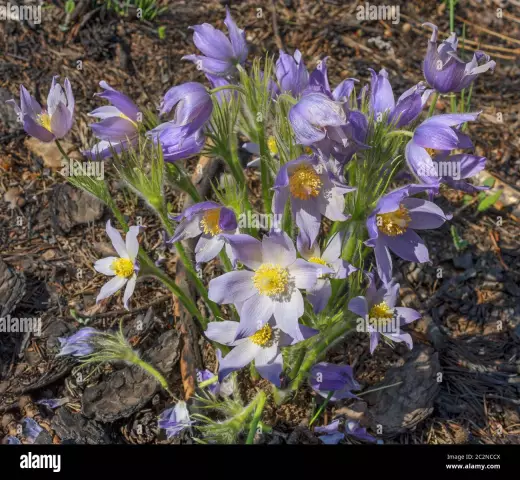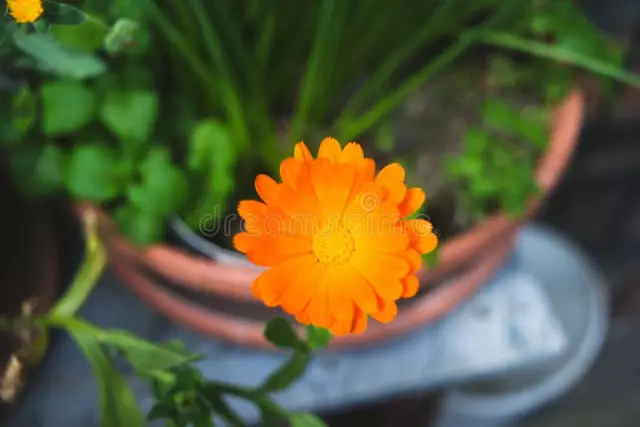- Author Rachel Wainwright [email protected].
- Public 2023-12-15 07:39.
- Last modified 2025-11-02 20:14.
Lumbago meadow
Instructions for use:
- 1. Application
- 2. Contraindications for use

Meadow lumbago is a herbaceous perennial plant that has a powerful vertical rhizome. The lumbago blooms until the leaves open. There are many popular names for the plant, among which are sleep-grass, sheep grass, arrow grass, bough, dream book, purr, lumbago, arrow, samson. The basal leaves of the grass are lowered, dissected into three segments, which, in turn, are divided into 2 sections, each of which "bears" still pointed toothed slices (in the amount of 2-4).
During flowering, the flower stalks of the meadow lumbago are covered with soft thick hairs. The dream-grass has a "veil" formed by three leaves that have grown together at the base - it is annular, divided into linear, very hairy lobules. Flowers are broadly bell-shaped. On the lumbago there are 6 ovate-pointed, blue-violet hairy leaves, 3-4 cm long. The stamens of the lumbago are yellow, they are slightly shorter than the leaves. Sleep grass fruits are 3-5 cm long and have a very hairy column.
The flowering period is in the second half of spring (end of April - May). The herb is widespread in the European part of Russia, in Belarus and Ukraine. Most often it grows on forest edges, dry slopes, open sandy hills and in pine forests.
The use of meadow lumbago
For medicinal purposes, only leaves that are harvested during the flowering period of meadow lumbago can be used.
The plant contains the steroid sitosterol, triterpenoid beta-armine, gamma-lactone ranunculin, cholic acid and gamma-pyrone derivatives. The roots of the plant contain saponins. The ground part of the lumbago is rich in organic acids, gamma lactone, essential oil, anemonin. The stems contain traces of alkaloids, which are also found in the leaves of the plant. By the way, the leaves are still rich in vitamin C. But during the research, anthocyanins (delphinidin and perargopilin glycosides) and traces of alkaloids were found in the flowers of the plant.
Traditional medicine uses meadow lumbago as a good hypnotic and sedative. The plant has a bactericidal, fungicidal, coughing, anti-inflammatory and bactericidal effect. The herb infusion is widely used for articular rheumatism, whooping cough, female diseases, bronchial asthma and bronchitis.
The aerial part of the meadow lumbago is used in homeopathy for the treatment of nervous diseases, amenorrhea, measles, gastritis, inflammation of the Eustachian tube, menstrual irregularities, as well as for conjunctivitis, metabolic disorders, diseases of the urinary tract and kidneys.
A decoction from the aerial parts of the plant in Northeast China is used as an expectorant, and an aqueous extract from a dream herb is used in Belarus for fungal skin lesions and wound dressing.

To prepare the infusion of meadow lumbago, you need to pour 10 g of finely chopped plant with a glass of cold water, leave this mixture for a day, and then strain it. It is used exclusively externally for the treatment of skin diseases. In small doses, the infusion is recommended by traditional medicine of Belarus for the treatment of cough and female diseases. In the same country, the plant's tincture on vodka is rubbed on the skin for rheumatism. Fresh lumbago grass floats in the oven and receives a special juice, which can be used to treat burns in the future.
Bulgarian traditional medicine recommends the use of remedies based on meadow lumbago for neuralgia, diseases of the female genital organs, bronchitis, whooping cough and migraine, rheumatism and gout. In Bulgaria, sleep-grass is also considered a diaphoretic and diuretic.
Very often the plant is used in the form of a cold infusion, which can be prepared by pouring a glass of boiled water, cooled to room temperature, 2 tsp. chopped herbs, then leave for 24 hours and strain. You need to take the infusion in small sips.
Contraindications to the use of meadow lumbago
Since meadow lumbago is a very poisonous plant, you should be very careful when using the plant internally.
Lumbago preparations are categorically contraindicated for gastritis, nephritis and other gastrointestinal diseases. By the way, in many Russian regions there was previously a belief in which it was indicated that this plant was cursed by the Mother of God.
Information about the drug is generalized, provided for informational purposes only and does not replace the official instructions. Self-medication is hazardous to health!






